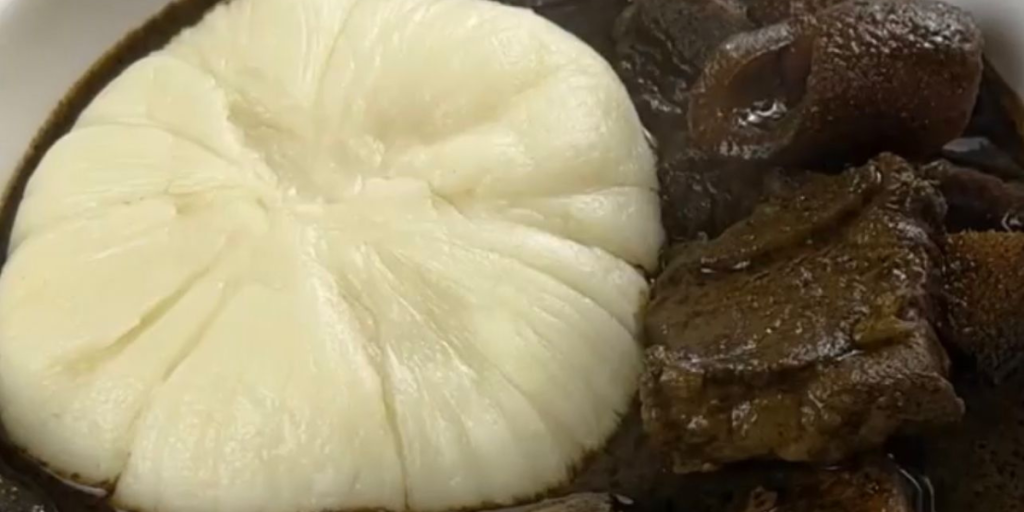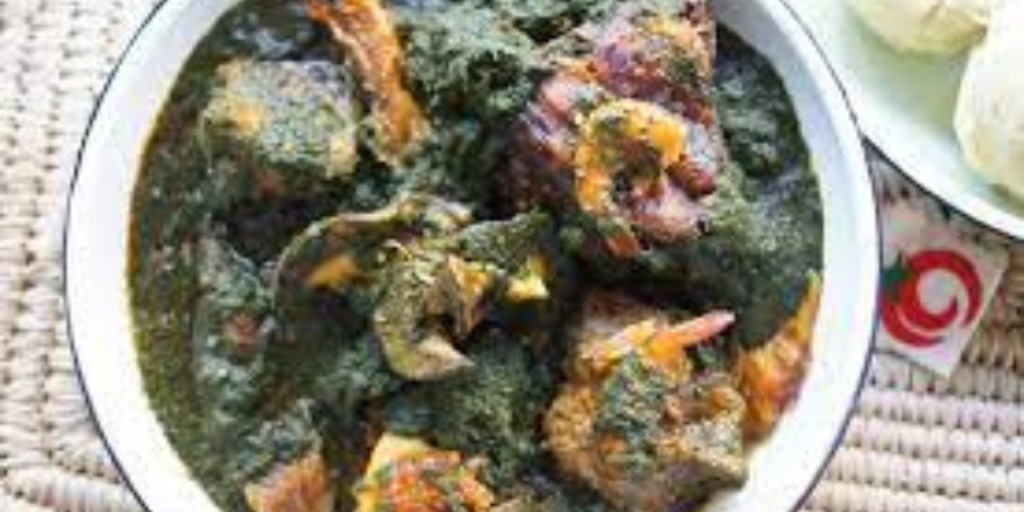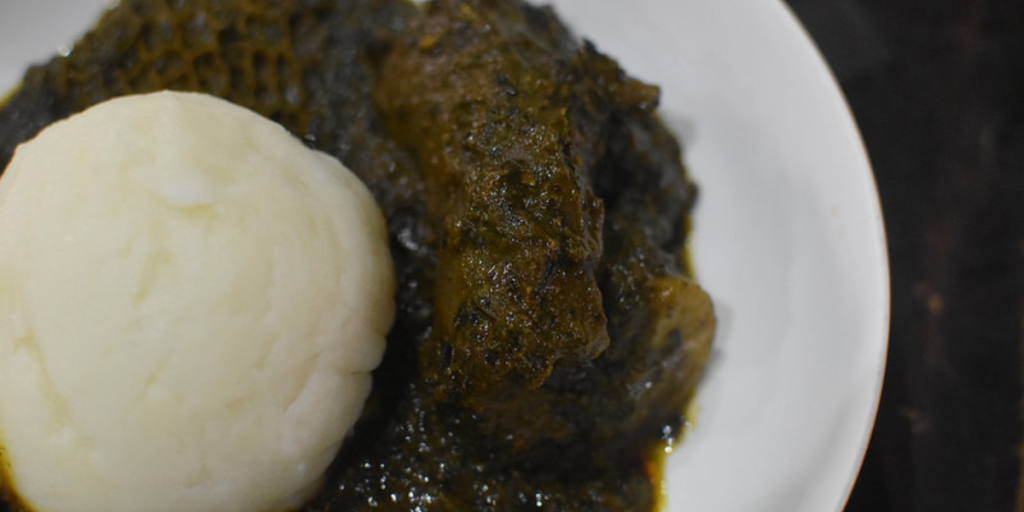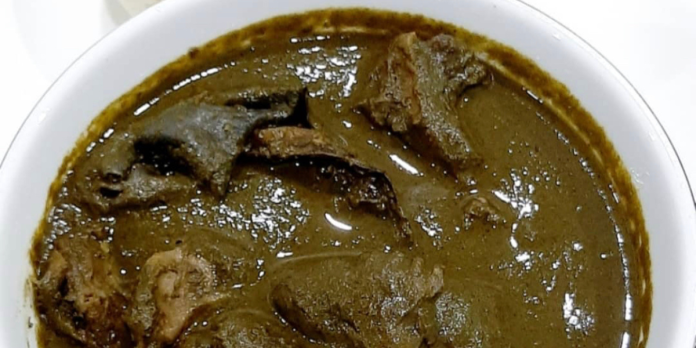Table of Contents
Benin Black Soup, also known as Ofe Owerri or Ofe Nsala in some regions, is a rich and flavorful traditional soup originating from the Benin people of Nigeria. Known for its deep, dark color and rich taste, this soup is a favorite for its unique blend of ingredients and the cultural heritage it represents. Making Benin Black Soup can seem daunting, but with the right steps and techniques, you can master this dish and enjoy a taste of Nigerian cuisine at home.
Ingredients

To make authentic Benin Black Soup, you’ll need the following ingredients:
- Cocoyam: This is used as a thickening agent. It gives the soup its smooth and rich texture. You can find cocoyam in African or international grocery stores.
- Palm Oil: Essential for the soup’s flavor and color, palm oil adds a distinct taste that’s hard to replicate with other oils.
- Meat: Common choices include goat meat, beef, or chicken. Some recipes also use assorted meats like tripe or cow skin.
- Fish: Adding smoked or dried fish can enhance the flavor profile of the soup.
- Ground Crayfish: This adds a unique, slightly sweet seafood flavor.
- Seasonings: Onions, fresh and dried peppers, seasoning cubes, and salt are essential for flavoring the soup.
- Vegetables: Bitter leaf or scent leaf is traditionally used to add a slightly bitter taste, balancing the richness of the soup.
Selecting and Preparing Ingredients
- Cocoyam: Choose firm and fresh cocoyam tubers. Peel and cut them into small pieces for easy cooking.
- Meat: Select fresh meat, preferably from a reputable butcher. Ensure it’s cleaned and cut into bite-sized pieces.
- Fish: If using dried or smoked fish, soak it in warm water to rehydrate and remove any bones.
- Vegetables: Wash and shred the vegetables thoroughly to remove any dirt or sand.
Preparation of Cocoyam
- Peeling and Cooking Cocoyam:
- Peel the cocoyam tubers with a sharp knife. Be careful, as the skin can be tough.
- Cut the peeled cocoyam into smaller chunks for faster cooking.
- Boil the cocoyam pieces in water until they are tender and can be easily pierced with a fork, usually about 15-20 minutes.
- Blending or Pounding Cocoyam:
- Once cooked, drain the water and allow the cocoyam to cool slightly.
- Blend the cocoyam into a smooth paste using a blender or food processor. If you prefer traditional methods, you can pound the cocoyam using a mortar and pestle.
- Ensure the paste is smooth with no lumps, as this will affect the texture of the soup.
Common Mistakes to Avoid:
- Overcooking or undercooking the cocoyam can lead to an inconsistent texture.
- Ensure the cocoyam paste is smooth to avoid lumps in the soup.
What are the ingredients in black soup in Ondo? 2024
Preparing the Meat and Fish
- Cleaning and Cutting Meat and Fish:
- Wash the meat thoroughly under running water to remove any blood or impurities.
- Cut the meat into uniform pieces to ensure even cooking.
- For fish, remove any scales and bones if necessary, especially if using whole fish.
- Marinating Techniques:
- Marinating meat enhances its flavor. Use a mix of seasoning cubes, salt, and pepper to marinate the meat.
- Let the meat sit in the marinade for at least 30 minutes to absorb the flavors.
- Cooking Meat and Fish:
- In a large pot, heat a small amount of palm oil and sauté onions until translucent.
- Add the marinated meat and cook until browned on all sides.
- If using fish, add it towards the end of the cooking process to prevent it from falling apart.
Ondo Black Soup 2024 Best Guide
Making the Soup Base
- Preparing the Soup Base:
- In a large pot, heat palm oil until it melts and becomes slightly translucent.
- Add chopped onions and sauté until golden brown.
- Incorporate ground crayfish and peppers, stirring continuously to release their flavors.
- Incorporating Palm Oil and Seasonings:
- Add more palm oil if necessary to achieve the desired richness.
- Stir in the blended cocoyam paste gradually, ensuring it dissolves smoothly into the soup base.
- Season with salt, seasoning cubes, and any other spices to taste.
- Achieving the Right Consistency:
- The cocoyam paste will thicken the soup as it cooks. Stir frequently to prevent sticking and burning.
- Add water gradually to achieve your preferred soup consistency, whether thick or slightly runny.
What Are The Benefits of Black soup best 2024
Combining Ingredients

- Adding Cocoyam Paste:
- Gradually add the cocoyam paste to the soup base, stirring continuously to prevent lumps.
- Ensure the paste is fully incorporated and the soup begins to thicken.
- Blending Flavors and Ensuring Smooth Texture:
- Add the cooked meat and fish to the soup, allowing the flavors to meld together.
- Let the soup simmer on low heat for about 20-30 minutes, stirring occasionally.
- Add the shredded vegetables (bitter leaf or scent leaf) and cook for an additional 5-10 minutes.
- Cooking Times and Temperature Control:
- Monitor the soup closely to prevent overcooking the vegetables, which should remain slightly crunchy.
- Adjust seasoning as necessary, tasting and correcting any imbalances.
Serving and Enjoying
- Traditional Serving Suggestions:
- Serve Benin Black Soup hot, accompanied by traditional sides like pounded yam, fufu, or rice.
- For a more authentic experience, serve the soup in traditional earthenware bowls.
- Side Dishes That Complement Benin Black Soup:
- Pounded yam: A soft, dough-like side made from boiled and pounded yam.
- Fufu: Made from cassava, yams, or plantains, this starchy side pairs well with the rich soup.
- Rice: Steamed white rice is a simple yet perfect companion for the flavorful soup.
- Presentation Tips for a Beautiful Meal:
- Garnish the soup with a few fresh leaves of bitter leaf or scent leaf.
- Serve with a side of sliced onions and peppers for added crunch and flavor.
Black Soup Recipe Best of 2024
Variations and Adaptations
- Exploring Regional Variations:
- Some regions use different thickening agents like yam or cassava instead of cocoyam.
- The type of meat and fish used can vary, allowing for personal or regional preferences.
- Vegetarian or Alternative Versions:
- Substitute meat and fish with a variety of mushrooms or tofu for a vegetarian version.
- Use vegetable broth instead of meat broth for added depth of flavor.
- Adjusting Spice Levels:
- For a milder version, reduce the amount of fresh and dried peppers.
- Experiment with different types of peppers to find the heat level that suits your taste.
Frequently Asked Questions
- What is Benin Black Soup?
- Benin Black Soup is a traditional Nigerian soup known for its deep color and rich flavor. It’s made with ingredients like cocoyam, palm oil, meat, and vegetables, creating a hearty and satisfying dish.
- Can I use substitutes for cocoyam?
- Yes, you can use alternatives like yam or cassava, though the texture and flavor might differ slightly. Ensure they are cooked and blended smoothly.
- How can I make the soup less spicy?
- To reduce the spiciness, use fewer fresh and dried peppers. You can also add more palm oil or cocoyam paste to balance the heat.
- What are some common mistakes when making Benin Black Soup?
- Overcooking or undercooking cocoyam, not blending the cocoyam paste smoothly, and using too much or too little palm oil can affect the soup’s texture and flavor.
- How long does Benin Black Soup last, and how should I store it?
- Benin Black Soup can last up to 5 days in the refrigerator. Store it in an airtight container to maintain its freshness.
- Can I freeze Benin Black Soup?
- Yes, you can freeze Benin Black Soup for up to 3 months. Allow it to cool completely before transferring to freezer-safe containers. Thaw in the refrigerator before reheating.
- What side dishes go well with Benin Black Soup?
- Traditional sides like pounded yam, fufu, and rice pair well with the rich flavors of Benin Black Soup. These starchy sides help balance the soup’s intensity.
Best 5 Nigerian Soup You Must Try In 2024
Conclusion

Making Benin Black Soup is a rewarding culinary experience that connects you with Nigerian culture and traditions. By following these steps and tips, you can create a delicious and authentic dish that will impress your family and friends. Enjoy the process, experiment with flavors, and savor the rich taste of this traditional soup.
- Glossary of Terms:
- Cocoyam: A starchy tuber used for thickening soups.
- Palm Oil: A reddish oil extracted from the fruit of the oil palm tree, used for its flavor and color.
- Crayfish: Small, freshwater crustaceans often ground into a powder for seasoning.
- Nutritional Information:
- Benin Black Soup is rich in protein from the meat and fish, healthy fats from palm oil, and essential vitamins and minerals from the vegetables.
- Resource List:
- International grocery stores for ingredients.
- Cookbooks and websites on Nigerian cuisine for further exploration of traditional recipes.





















